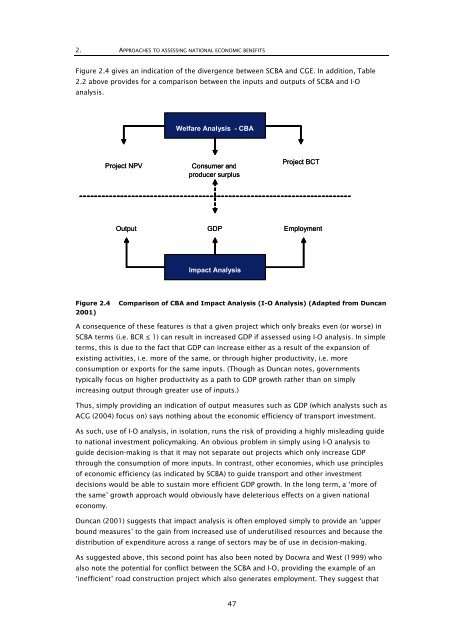Research 350 - NZ Transport Agency
Research 350 - NZ Transport Agency
Research 350 - NZ Transport Agency
Create successful ePaper yourself
Turn your PDF publications into a flip-book with our unique Google optimized e-Paper software.
2. APPROACHES TO ASSESSING NATIONAL ECONOMIC BENEFITS<br />
Figure 2.4 gives an indication of the divergence between SCBA and CGE. In addition, Table<br />
2.2 above provides for a comparison between the inputs and outputs of SCBA and I-O<br />
analysis.<br />
Welfare Analysis - CBA<br />
Project NPV<br />
Consumer and<br />
producer surplus<br />
Project BCT<br />
Output<br />
GDP<br />
Employment<br />
Impact analysis Analysis<br />
Figure 2.4<br />
2001)<br />
Comparison of CBA and Impact Analysis (I-O Analysis) (Adapted from Duncan<br />
A consequence of these features is that a given project which only breaks even (or worse) in<br />
SCBA terms (i.e. BCR ≤ 1) can result in increased GDP if assessed using I-O analysis. In simple<br />
terms, this is due to the fact that GDP can increase either as a result of the expansion of<br />
existing activities, i.e. more of the same, or through higher productivity, i.e. more<br />
consumption or exports for the same inputs. (Though as Duncan notes, governments<br />
typically focus on higher productivity as a path to GDP growth rather than on simply<br />
increasing output through greater use of inputs.)<br />
Thus, simply providing an indication of output measures such as GDP (which analysts such as<br />
ACG (2004) focus on) says nothing about the economic efficiency of transport investment.<br />
As such, use of I-O analysis, in isolation, runs the risk of providing a highly misleading guide<br />
to national investment policymaking. An obvious problem in simply using I-O analysis to<br />
guide decision-making is that it may not separate out projects which only increase GDP<br />
through the consumption of more inputs. In contrast, other economies, which use principles<br />
of economic efficiency (as indicated by SCBA) to guide transport and other investment<br />
decisions would be able to sustain more efficient GDP growth. In the long term, a ‘more of<br />
the same’ growth approach would obviously have deleterious effects on a given national<br />
economy.<br />
Duncan (2001) suggests that impact analysis is often employed simply to provide an ‘upper<br />
bound measures’ to the gain from increased use of underutilised resources and because the<br />
distribution of expenditure across a range of sectors may be of use in decision-making.<br />
As suggested above, this second point has also been noted by Docwra and West (1999) who<br />
also note the potential for conflict between the SCBA and I-O, providing the example of an<br />
‘inefficient’ road construction project which also generates employment. They suggest that<br />
47
















